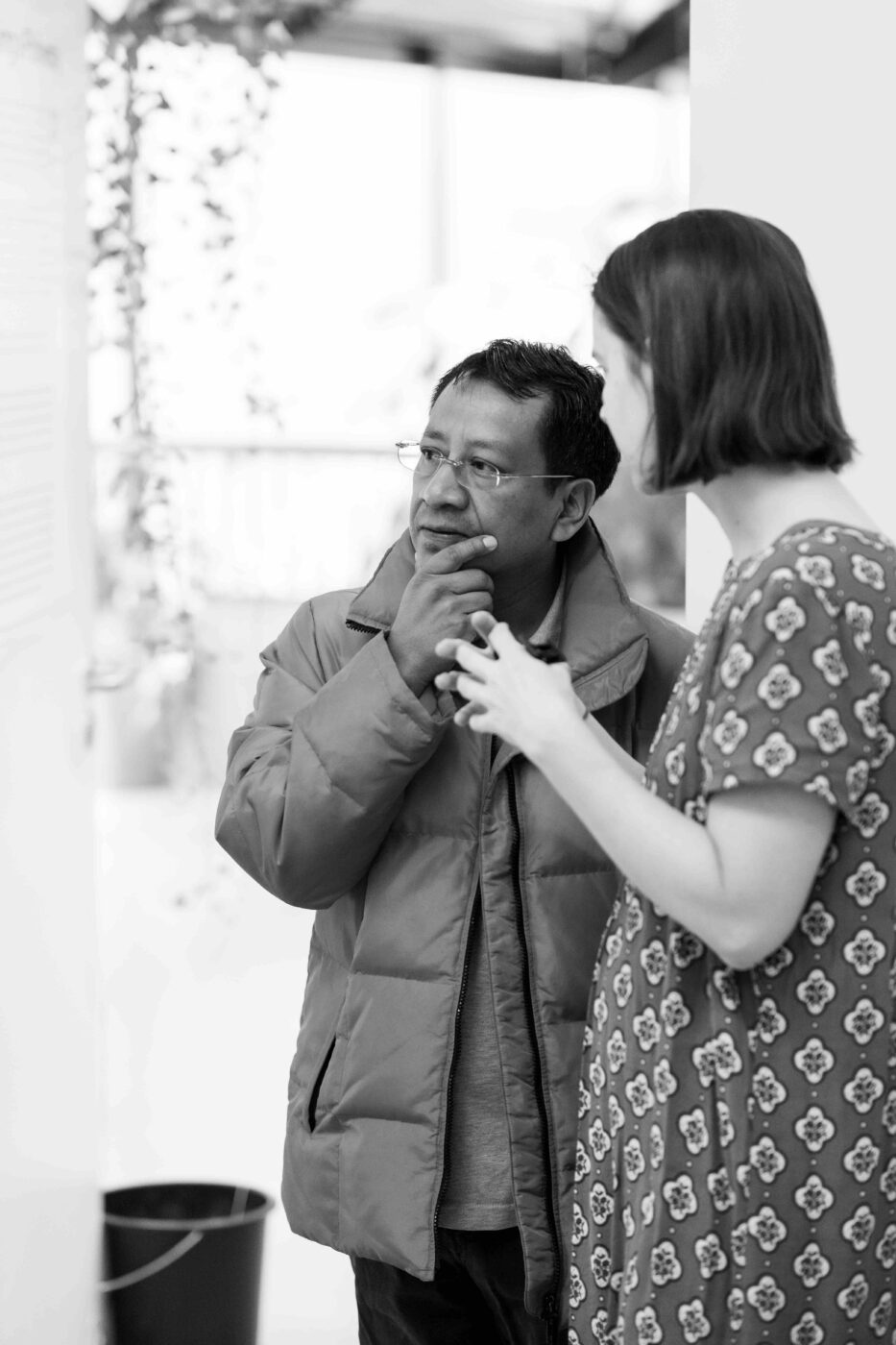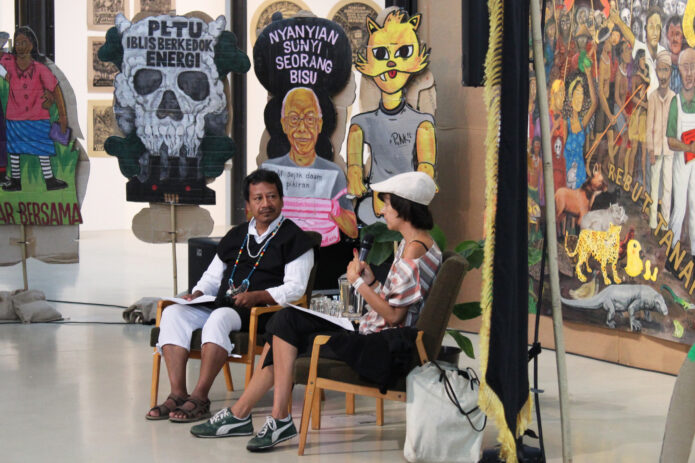 Hernando Chindoy en Camila Gueneau de Mussy Zegers tijdens het programma Weaving a Pluriversity (2024) bij Framer Framed, Amsterdam. Foto: © Lina van den Idsert / Framer Framed.
Hernando Chindoy en Camila Gueneau de Mussy Zegers tijdens het programma Weaving a Pluriversity (2024) bij Framer Framed, Amsterdam. Foto: © Lina van den Idsert / Framer Framed. "For us, knowledge and spirituality are not separate" - in conversation with Indigenous leader Hernando Chindoy
In May 2024, Inga leader Hernando Chindoy spent a period as artist-in-residence at Framer Framed. Together with his partner Cristina Rodriguez, they participated in Planetary Poetics – a temporary master’s programme initiated by Dorine van Meel and Framer Framed at the Sandberg Institute. During this time, they worked together with artist Milena Bonilla as part of the series of workshops Towards ËCONEÊRÃ, an exercise in solidarity. The series engaged with listening and sharing exercises, around questions of land healing and narratives that have been historically made invisible by Western thought.
Rosa Hofgärtner interviewed Hernando Chindoy for Down to Earth Magazine.
Hernando Chindoy’s community in Colombia traded the cultivation of poppies for coffee and fruit and in doing so escaped drug violence: “We may now be poorer in terms of money, but much richer in terms of knowledge, biodiversity and quality of life.”
For several months, Indigenous Inga leader Hernando Chindoy is a guest at Framer Framed, a platform for contemporary art and visual culture in Amsterdam. Together with artist Milena Bonilla, he is working to strengthen the traditional knowledge, medicine and language of the Inga from Colombia.
Chindoy, who received an honorary doctorate from the University of Arts in London for his work, talks about the area where he grew up. Camila Gueneau de Mussy-Zegers, team member at Framer Framed, acts as translator. This brings the number of languages used to four: Inga, Spanish, English and Dutch. We hope nothing of the conversation got lost in translation.
Drug violence and glyphosate
“I was born in the Andes mountains, on the border of Colombia and Ecuador,” Chindoy says. “I grew up with 14 siblings. The area I come from is known as the land of volcanoes and is the origin of the rivers Putumayo, Caquetá and Patía. The area is connected to the waterways of the Amazon and the Chocó Biogeográfico (Pacific Ocean – ed.).”

Chindoy grew up in an Inga community that lived in isolation in the mountains for a long time. “We were surrounded by rich biodiversity,” he says. That came to an end in the 1980s, with the arrival of criminal organisations who devoted themselves to producing and trafficking drugs such as morphine and heroin. The violence that accompanied this was disastrous for the Indigenous population. The biodiversity suffered badly from the widespread use of glyphosate in poppy cultivation. Indigenous knowledge and medicine increasingly faded into the background. Chindoy: “My grandparents still had a lot of Indigenous knowledge: for them, we and the land are one and the Earth is our mother. This way of thinking was lost because of people coming from outside.”
The repression of Indigenous knowledge has a long history, starting with the rise of colonialism. Indigenous children, for instance, were not allowed to speak their own language in the missionary schools that were founded, even though this was the only education available for a long time. “The education the colonists brought with them was not geared to us at all. They had no regard for who we were and how we lived. My parents’ generation stopped using the traditional language or the traditional way of dressing. They no longer valued the land as part of themselves but as something to be traded and commercialised. As a result, a lot of our knowledge was lost.” At the end of the last century, Chindoy’s community had been dominated by drug violence for over 15 years, resulting in many deaths. The Inga were balancing on the brink of extinction, physically and culturally.
Wuasikamas
The year 2003 marked a turning point. Chindoy played a major role in bringing his community together to discuss how they could put an end to the violence and restore their own identity. He succeeded in convincing more than 4,000 Indigenous people and local farmers to collectively abandon poppy cultivation. About 22,000 hectares became the property of the collective, and traditional knowledge and practices became central to the management of the land. Most of the land has been designated a sacred area where strict environmental protection applies. Coffee, sugar and fruit, for example, are grown on the remaining land. The products are sold under the label Wuasikamas, which means ‘Guardians of the Earth’.
Poorer, but also richer
The death toll dropped significantly, and the condor, tapir, spectacled bear and deer returned to the area. Chindoy’s efforts were awarded the UN Development Programme’s Equator Prize. “We may now be poorer in terms of money, but much richer in terms of knowledge, biodiversity and quality of life.” Chindoy hopes this upheaval can set an example, especially for other Indigenous peoples. “There are 115 different Indigenous peoples in Colombia, 70 of which are seriously threatened with extinction. If they are no longer there, their knowledge will also be lost. Every 15 days a language disappears, mainly of Indigenous peoples. It is then not only the language that disappears, but also the way of thinking that enabled people to live and survive in those circumstances.
The establishment of Wuasikamas has brought about a revival of Indigenous knowledge and practices, but the vast majority of Inga still receive little formal education. Since there is no higher education in the area, young people are forced to travel to other places, which is often difficult due to a lack of money. Those who do get their degrees somewhere else often do not return.
An alternative to universities
Chindoy wants to change that. He wants to develop so-called ‘pluriversities’ to give more people access to higher education focused on traditional knowledge. “The pluriversity brings together different communities with different cultures and perspectives to work on collective goals, such as protecting biodiversity and fighting poverty.” The pluriversity should be an alternative to universities dominated by a Western understanding of scientific knowledge. Western science contributes to the “progress of humanity” by treating the earth and all natural beings as objects, he explains. “Indigenous communities, however, protect about 80 per cent of the world’s biodiversity on only 20 per cent of the earth’s surface, relying on very different forms of knowledge.”
What strikes Chindoy most about Western science is its bleakness. “Western knowledge can go very deep, but without spirituality, there is no connection. For us, knowledge and spirituality are inseparable. That is why Indigenous knowledge is so meaningful: since we can communicate with the heart, mind and soul, we can listen to that which cannot be seen but can be felt.

Taita Hernando Chindoy and Milena Bonilla in conversation during the exhibition Tanah Merdeka by Taring Padi. Photo: Padrick Stam / Framer Framed
From the equator to the pole
Instead of using knowledge to accumulate power and wealth, the pluriversity aims to help ensure that humans and non-humans can coexist equally. The pluriversity covers a broad spectrum and is based on the biocultural principle that nature and culture are strongly intertwined. “An important element is the connection with the territory. The land is a teacher with a lot of knowledge,” Chindoy says. “Trees are also educators, as are the jaguar, the anaconda and the spectacled bear.”
Pluriversities are being established in several places, each with its own focus and character. Chindoy has now set his his sights mainly on the ËCONEÊRÃ pluriversity, which will welcome about 400 students for the first time in 2026. “We are targeting young people because they are the generation that will ensure the survival of species. The idea is for all students to be part of a community linked to a particular territory. In this way, education will be linked to the protection of that territory. We want to offer every student a scholarship and are now busy looking for funding.”
Chindoy continued: “Our goal after 12 years is to protect approximately 5 million hectares of land in different regions of the earth – from the equator to the polar region – through ËCONEÊRÃ. We think it is important to bring this way of thinking and doing to different latitudes on earth. What happens in one place on earth affects other places. After all, the earth is one whole.”
Text by Rosa Hofgärtner
Originally published in Down to Earth Magazine, platform for environmental journalism, 11 June 2024
Colombia / Ecology / Colonial history /
Agenda
A Harvest for All: Notes on Biodiversity and Medicine
A conversation between Milena Bonilla & Taita Hernando Chindoy
Network
